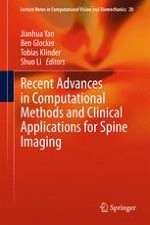2015 | OriginalPaper | Chapter
Lumbar and Thoracic Spine Segmentation Using a Statistical Multi-object Shape\(+\)Pose Model
Authors : A. Seitel, A. Rasoulian, R. Rohling, P. Abolmaesumi
Published in: Recent Advances in Computational Methods and Clinical Applications for Spine Imaging
Publisher: Springer International Publishing
Activate our intelligent search to find suitable subject content or patents.
Select sections of text to find matching patents with Artificial Intelligence. powered by
Select sections of text to find additional relevant content using AI-assisted search. powered by
